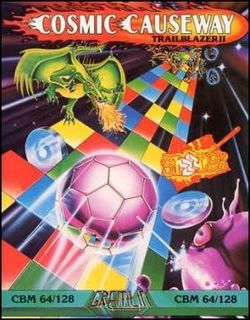- Cosmic Causeway: Trailblazer II
-
Cosmic Causeway: Trailblazer II 
Publisher(s) Gremlin Interactive Platform(s) Commodore 64 Release date(s) 1987 Cosmic Causeway was the sequel to Trailblazer written by Shaun Southern. While the original game featured a split-screen two player mode, the sequel is single-player only. The display is a full screen 3D view of the "road" ahead. Another major change is the addition of tunnels, with the player able to roll along upside down if the necessary icon has been selected.
Contents
Gameplay
The player controls a ball that is being affected by the coloured squares on the road:
- Black squares are holes, and the ball will fall through them, wasting valuable time
- Red squares slow the ball down
- Green squares speed the ball up slightly and make it jump
- Blue squares make the ball jump higher
- Purple squares stop the ball and send it backwards
- Cyan/turquoise squares reverse the controls, making things more difficult
On each level there is a glowing ball to collect for credits. At the start of the level these could be spent to add an extra feature to the ball, shown by the icons at the bottom of the screen:
- x3 - x3 score multiplier (2 credits)
- Ceiling - let the ball jump to the "ceiling" of the level and roll along it (3 credits)
- Stop cyan - prevents controls being reversed (4 credits)
- Stop purple - stop purple squares halting the ball (4 credits)
- Superspeed - accelerates the ball to a higher speed (5 credits)
- Shield - kills enemies on contact (6 credits)
- Float - stops the ball falling through holes (7 credits)
- Time slow - slows down the timer (7 credits)
On many levels there are enemies to be shot, by holding the joystick forward. At the end of certain levels are large enemy dragons, inspired by the game Space Harrier, which must be destroyed before the time runs out. Other hazards include large yellow walls with doors that open and close.
A timer ticks down constantly, and only stops when the player reaches the grey tiles that mark the end of a level. Remaining time is carried over to the next level, and a bonus score awarded based on the number of seconds left. (The timer is reset after each dragon level).
There are 24 levels in total. At the end of the game a rating is awarded, from Hilarious to Superblazer for completing the game.
Reception
The game was reviewed in 1990 in Dragon #158 by Hartley, Patricia, and Kirk Lesser in "The Role of Computers" column, as part of the Mastertronic MEGA Pack of 10 games previously released in Europe. The reviewers gave the game 3 out of 5 stars, stating "It has 24 “roads” to travel; quite interesting".[1]
References
- ^ Lesser, Hartley, Patricia, and Kirk (June 1990). "The Role of Computers". Dragon (158): 47–54.
External links
Categories:- 1987 video games
- Commodore 64 games
- Gremlin Interactive games
- Puzzle video game stubs
Wikimedia Foundation. 2010.
